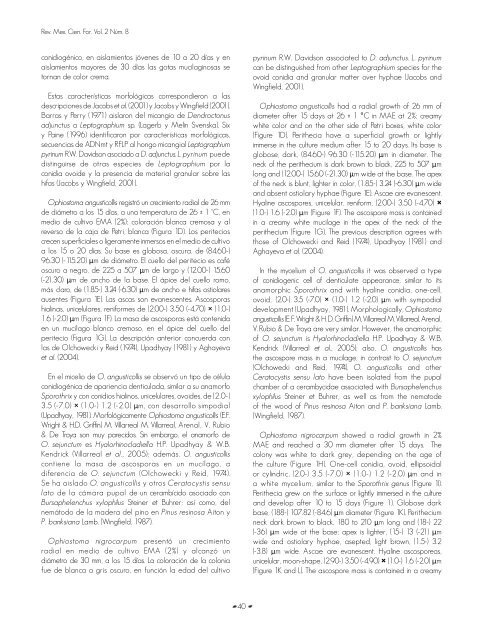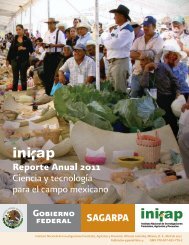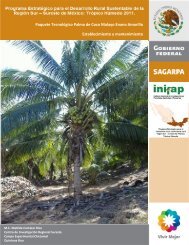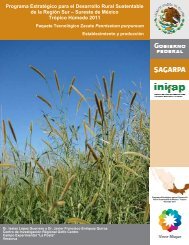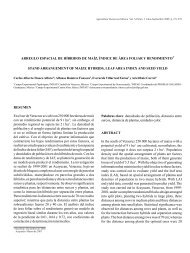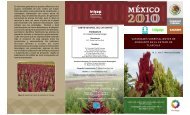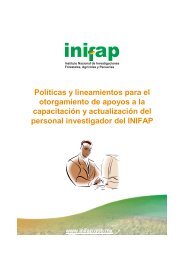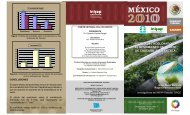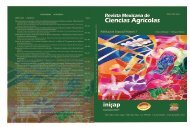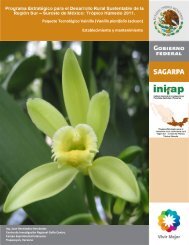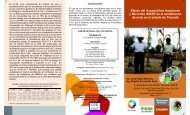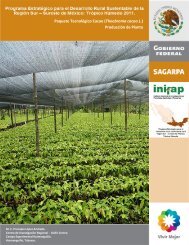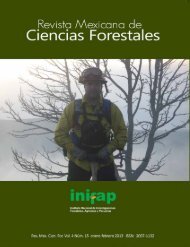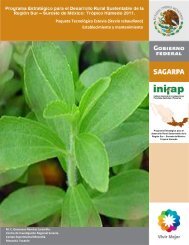Vol. 2 Núm. 8 - Instituto Nacional de Investigaciones Forestales ...
Vol. 2 Núm. 8 - Instituto Nacional de Investigaciones Forestales ...
Vol. 2 Núm. 8 - Instituto Nacional de Investigaciones Forestales ...
- No tags were found...
Create successful ePaper yourself
Turn your PDF publications into a flip-book with our unique Google optimized e-Paper software.
Rev. Mex. Cien. For. <strong>Vol</strong>. 2 Núm. 8conidiogénico, en aislamientos jóvenes <strong>de</strong> 10 a 20 días y enaislamientos mayores <strong>de</strong> 30 días las gotas mucilaginosas setornan <strong>de</strong> color crema.Estas características morfológicas correspondieron a las<strong>de</strong>scripciones <strong>de</strong> Jacobs et al. (2001) y Jacobs y Wingfield (2001).Barras y Perry (1971) aislaron <strong>de</strong>l micangio <strong>de</strong> Dendroctonusadjunctus a Leptographium sp. (Lagerb y Melin Svenska). Sixy Paine (1996) i<strong>de</strong>ntificaron por características morfológicas,secuencias <strong>de</strong> ADNmt y RFLP al hongo micangial Leptographiumpyrinum R.W. Davidson asociado a D. adjunctus. L. pyrinum pue<strong>de</strong>distinguirse <strong>de</strong> otras especies <strong>de</strong> Leptographium por laconidia ovoi<strong>de</strong> y la presencia <strong>de</strong> material granular sobre lashifas (Jacobs y Wingfield, 2001).Ophiostoma angusticollis registró un crecimiento radial <strong>de</strong> 26 mm<strong>de</strong> diámetro a los 15 días, a una temperatura <strong>de</strong> 26 ± 1 °C, enmedio <strong>de</strong> cultivo EMA (2%); coloración blanca cremosa y alreverso <strong>de</strong> la caja <strong>de</strong> Petri, blanca (Figura 1D). Los peritecioscrecen superficiales o ligeramente inmersos en el medio <strong>de</strong> cultivoa los 15 o 20 días. Su base es globosa, oscura, <strong>de</strong> (84.60-)96.30 (-115.20) μm <strong>de</strong> diámetro. El cuello <strong>de</strong>l peritecio es caféoscuro a negro, <strong>de</strong> 225 a 507 μm <strong>de</strong> largo y (12.00-) 15.60(-21.30) μm <strong>de</strong> ancho <strong>de</strong> la base. El ápice <strong>de</strong>l cuello romo,más claro, <strong>de</strong> (1.85-) 3.24 (-6.30) μm <strong>de</strong> ancho e hifas ostiolaresausentes (Figura 1E). Las ascas son evanescentes. Ascosporashialinas, unicelulares, reniformes <strong>de</strong> (2.00-) 3.50 (-4.70) × (1.0-)1.6 (-2.0) μm (Figura 1F). La masa <strong>de</strong> ascosporas está contenidaen un mucílago blanco cremoso, en el ápice <strong>de</strong>l cuello <strong>de</strong>lperitecio (Figura 1G). La <strong>de</strong>scripción anterior concuerda conlas <strong>de</strong> Olchowecki y Reid (1974), Upadhyay (1981) y Aghayevaet al. (2004).En el micelio <strong>de</strong> O. angusticollis se observó un tipo <strong>de</strong> célulaconidiogénica <strong>de</strong> apariencia <strong>de</strong>nticulada, similar a su anamorfoSporothrix y con conidios hialinos, unicelulares, ovoi<strong>de</strong>s, <strong>de</strong> (2.0-)3.5 (-7.0) × (1.0-) 1.2 (-2.0) μm, con <strong>de</strong>sarrollo simpodial(Upadhyay, 1981). Morfológicamente Ophiostoma angusticollis (E.F.Wright & H.D. Griffin) M. Villarreal M. Villarreal, Arenal, V. Rubio& De Troya son muy parecidos. Sin embargo, el anamorfo <strong>de</strong>O. sejunctum es Hyalorhinocladiella H.P. Upadhyay & W.B.Kendrick (Villarreal et al., 2005); a<strong>de</strong>más, O. angusticolliscontiene la masa <strong>de</strong> ascosporas en un mucílago, adiferencia <strong>de</strong> O. sejunctum (Olchowecki y Reid, 1974).Se ha aislado O. angusticollis y otros Ceratocystis sensulato <strong>de</strong> la cámara pupal <strong>de</strong> un cerambícido asociado conBursaphelenchus xylophilus Steiner et Buhrer; así como, <strong>de</strong>lnemátodo <strong>de</strong> la ma<strong>de</strong>ra <strong>de</strong>l pino en Pinus resinosa Aiton yP. banksiana Lamb. (Wingfield, 1987).Ophiostoma nigrocarpum presentó un crecimientoradial en medio <strong>de</strong> cultivo EMA (2%) y alcanzó undiámetro <strong>de</strong> 30 mm, a los 15 días. La coloración <strong>de</strong> la coloniafue <strong>de</strong> blanca a gris oscuro, en función la edad <strong>de</strong>l cultivopyrinum R.W. Davidson associated to D. adjunctus. L. pyrinumcan be distinguished from other Leptographium species for theovoid conidia and granular matter over hyphae (Jacobs andWingfield, 2001).Ophiostoma angusticollis had a radial growth of 26 mm ofdiameter after 15 days at 26 ± 1 °C in MAE at 2%; creamywhite color and on the other si<strong>de</strong> of Petri boxes, white color(Figure 1D). Perithecia have a superficial growth or lightlyimmerse in the culture medium after 15 to 20 days. Its base isglobose, dark, (84.60-) 96.30 (-115.20) μm in diameter. Theneck of the perithecium is dark brown to black, 225 to 507 μmlong and (12.00-) 15.60 (-21.30) μm wi<strong>de</strong> at the base. The apexof the neck is blunt, lighter in color, (1.85-) 3.24 (-6.30) μm wi<strong>de</strong>and absent ostiolary hyphae (Figure 1E). Ascae are evanescent.Hyaline ascospores, unicelular, reniform, (2.00-) 3.50 (-4.70) ×(1.0-) 1.6 (-2.0) μm (Figure 1F). The ascospore mass is containedin a creamy white mucilage in the apex of the neck of theperithecium (Figure 1G). The previous <strong>de</strong>scription agrees withthose of Olchowecki and Reid (1974), Upadhyay (1981) andAghayeva et al. (2004).In the mycelium of O. angusticollis it was observed a typeof conidiogenic cell of <strong>de</strong>nticulate appearance, similar to itsanamorphic Sporothrix and with hyaline conidia, one-cell,ovoid, (2.0-) 3.5 (-7.0) × (1.0-) 1.2 (-2.0) μm with sympodial<strong>de</strong>velopment (Upadhyay, 1981). Morphologically, Ophiostomaangusticollis (E. F. Wright & H. D. Griffin) M. Villarreal M. Villarreal, Arenal,V. Rubio & De Troya are very similar. However, the anamorphicof O. sejunctum is Hyalorhinocladiella H.P. Upadhyay & W.B.Kendrick (Villarreal et al., 2005); also, O. angusticollis hasthe ascospore mass in a mucilage, in contrast to O. sejunctum(Olchowecki and Reid, 1974). O. angusticollis and otherCeratocystis sensu lato have been isolated from the pupalchamber of a cerambycidae associated with Bursaphelenchusxylophilus Steiner et Buhrer, as well as from the nemato<strong>de</strong>of the wood of Pinus resinosa Aiton and P. banksiana Lamb.(Wingfield, 1987).Ophiostoma nigrocarpum showed a radial growth in 2%MAE and reached a 30 mm diameter after 15 days. Thecolony was white to dark grey, <strong>de</strong>pending on the age ofthe culture (Figure 1H). One-cell conidia, ovoid, ellipsoidalor cylindric, (2.0-) 3.5 (-7.0) × (1.0-) 1.2 (-2.0) μm and ina white mycelium, similar to the Sporothrix genus (Figure 1I).Perithecia grew on the surface or lightly immersed in the cultureand <strong>de</strong>velop after 10 to 15 days (Figure 1). Globose darkbase, (188-) 107.82 (-84.6) μm diameter (Figure 1K). Peritheciumneck dark brown to black, 180 to 210 μm long and (18-) 22(-36) μm wi<strong>de</strong> at the base; apex is lighter, (15-) 13 (-21) μmwi<strong>de</strong> and ostiolary hyphae, asepted, light brown, (1.5-) 3.2(-3.8) μm wi<strong>de</strong>. Ascae are evanescent. Hyaline ascosporeas,unicelular, moon-shape, (2.90-) 3.50 (-4.90) × (1.0-) 1.6 (-2.0) μm(Figure 1K and L). The ascospore mass is contained in a creamy40


